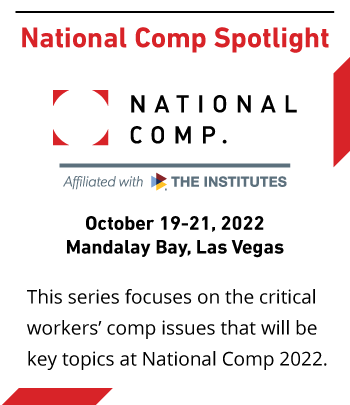Turnover Puts Lives and Dollars at Risk

Perhaps more than any other time in recent history, people are taking decisive action as to where, when, and how they choose to work. In February of this year alone, more than 4 million people left their jobs and many managers are scrambling to attract new workers.
 For companies whose operations have grown amidst the pandemic, the same challenge applies: how to keep teams adequately staffed?
For companies whose operations have grown amidst the pandemic, the same challenge applies: how to keep teams adequately staffed?
A large part of helping people remain in their jobs comes down to making sure they receive adequate safety training, especially within the first year of employment, according to experts.
Protecting new and inexperienced workers is a core concern for the National Comp conference, and an essential topic on this year’s program agenda. Sharita Green-Ngounda, strategic risk control consultant with PMA Companies, will share her extensive research at National Comp 2022 on Oct. 19, 2022. Green-Ngounda shared some of her thoughts with Risk & Insurance in advance of the presentation.
Just before the onset of the COVID-19 pandemic, the U.S. Bureau of Labor Statistics, along with insurance carriers, found that new workers — everywhere from restaurants to manufacturing plants and construction sites — experienced more than one-third of non-fatal workplace injuries, regardless of their age or industry experience.
Nearly three years into the pandemic, this trend has continued, and workers’ compensation experts are seeing the first six months on the job as prime time for non-fatal injuries among today’s employees.
As organizations navigate the current staffing flux, human resource and risk management teams have the golden opportunity to review their training approaches and ensure that their methods and tools are tailored to meet the needs of the people they employ.
Leadership teams that take steps to engage their employees and acknowledge the range of factors that influence how their team members learn, process and digest information will be better positioned to provide effective safety trainings.
Identifying Who May Be Underserved
Much of this awareness comes down to companies taking a close look at their injury data and considering how their previous training approaches may have been a product of systemic tendencies to overlook the unique needs of many of their workers.
“‘Underserved’ populations are considered marginalized because they tend to experience systemic limitations, bias or barriers in the workplace, thus minimizing their growth opportunities within the organization,” said Sharita Green-Ngounda, strategic risk control consultant, PMA Companies.
“Women, youth, disabled persons, ethnic and racial minorities would be considered groups within the ‘underserved’ worker population,” she explained.
But seeing trends in data can be tough, especially when companies are not required to disclose detailed demographic information when reporting injuries on a state and federal level.
Despite the efforts of safety researchers around the world, “gaps in safety and health data are unfortunately not a new challenge,” said John Dony, vice president of thought leadership at the National Safety Council.
“These data gaps are more troubling when considering minorities, underserved populations, and people who may have ‘invisible’ or undisclosed diversity or disability,” Dony said.
The Bureau of Labor Statistics’ Survey of Occupational Injuries and Illnesses is one example of a recordkeeping tool that does not require employers to disclose key demographic information such as race and ethnicity to help researchers and business leaders draw conclusions or identify insights.
“We can come by some of this information in an ad-hoc way by merging multiple data sources, but the gaps are numerous and large,” Dony said.
“Many studies conducted over the years have found that even for the general, more visible populace, work-related injuries (and particularly illnesses) are undercounted and [under]reported,” he said.
“This is typically not out of malice, although occasionally, there are active attempts to ‘hide’ events. More commonly, it is a result of gaps in reporting and surveillance systems available at a state and federal level,” Dony added.
“It’s an even greater challenge to collect data or understand issues that wouldn’t show up in existing demographic or contextual data even if it were perfect – such as neurodiversity,” Dony said.
What Will It Take to Meet Workers’ Training Needs?
So, how can HR and risk management teams tell if their safety and occupational trainings are geared toward effectively addressing the needs of everyone in their workforce?
For PMA Companies’ Green-Ngounda, there are a few telltale signs that indicate companies may be missing the inclusivity mark:
- Accident/injury data trends reflecting a negative impact on one particular demographic,
- A lack of training materials available in the languages spoken by the worker population, as well as any aids needed based on the cognitive or physical disabilities of employees, and
- Relying upon trainers and management that do not represent all aspects of a company’s worker population.
But there are ways to move the needle, Green-Ngounda said. “HR and risk management teams can determine the efficacy of their safety trainings by adopting the ‘Deming Cycle,’ utilizing the Plan, Do, Check and Act methodology.”
Examining reported incidents is just one way of determining if safety trainings are actually reaching employees. However, “they only show an outline of the ‘story’ omitting the critical details,” Green-Ngounda said.
Surveys, interviews, and small group feedback build the “true story” of training success and depict safety culture maturity, she added. “Combined they are all major determinants of organizational success.”
Much like cybersecurity, worker safety trainings must be constantly reinforced, according to Paul Vincent, workplace safety vice president at the National Safety Council.
“If you look at the amount of times that you do training online … about phishing attacks and computer security,” for example, “and how many people do that and still click on the links?” Vincent said.
It’s important to “… keep talking to your teams, training, [provide] ongoing training; just reinforcement of the key points that you need,” Vincent said.
“And actually, if you look at organizations that just train once and then forget about it … that information can be lost very quickly if it is not practiced.”
Overcoming the Barriers to Effective Connection
“Communication’s not really communication if it’s not received and understood well, right?” Vincent said.
“But if culturally there’s a miss…” that’s when problems arise, he said.
Vincent, whose previous work in private equity spanned 86 countries, shared an example of trainings he led while working for a French organization.
When the same trainings were given to employees in the UK and in Canada, “it was perceived completely differently by those people. It was the same language, same training content, but just different perceptions.”
“And so, I think the employers recognize this is a challenge in how to get training to the right people in a way that they understand it fully. And the good employers want to make that better, but it’s a challenge,” Vincent said.
The main barriers to effectively connecting with workers should be categorized by emotional, physical, cognitive and psychological, Green-Ngounda said, as they all share a role in knowledge transfer.
“It is critical that the learning environment establish emotional safety (ex. respect for cultural norms, cultural awareness, etc.) and trust as a priority for all learners,” Green-Ngounda said.
“All learning requires a certain degree of learner vulnerability for it to be successful and it should be protected at all costs.”
Conducting a needs assessment prior to learning opportunities can help remove physical barriers for all employees as well, Green-Ngounda said. “Unaddressed physical barriers can undermine learning from the onset and can create emotional or psychological barriers.”
There are also cognitive and psychological factors to consider when developing employee training modules.
Although employees are not required to disclose disabilities and neurodivergent conditions, “It is necessary to work in partnership with human resources when preparing training to learn about conditions that could make learning difficult such as ADD, ADHD, etc.,” Green-Ngounda said.
“Often many employees have been identified in prior learning environments with such challenges, but that information may or may not be transferred to the occupational learning environment,” she added.
Speaking the Same Language
The U.S. has long struggled to provide equitable access to information in the languages spoken by its ethnically diverse population.
As the country works to integrate a surge in people seeking refuge from global conflicts, accounting for the varying levels of English-language proficiency among staff may become a greater priority for some employers.
“There’s not enough effort put in engaging minority groups in smaller organizations — and rarely training people in their language,” Vincent said.
Particularly in industries such as construction and food processing that employ hourly and often transient workers, “you may have four or five language requirements to plan [for] at any one time,” Vincent said.
“Even if everyone is expected to speak English, they don’t necessarily recognize the nuances of what they’ve been taught … So, I do believe that culturally, the way we say things, the way we act has different meanings … The trainer needs to take those things into account,” he said.
“Language barriers also negatively impact learner confidence and misguide the overall learning experience,” Green-Ngounda said. “Language conversion while processing new information creates an enormous hurdle for the learner.”
Green-Ngounda recommends organizations utilize secondary reinforcements such as hands-on experiences and peer mentorship to make sure knowledge transfer is successful.
Empowering Employees
In today’s world, where time is of the essence, there’s always a perceived pressure on people to cut corners, and everyone needs to be reminded, “… your safety is important,” Vincent said.
Senior management has an inherent responsibility to keep staff safety at the forefront, but employees can take action as well to ensure that their safety needs are addressed, according to Green-Ngounda.
“Employees need to recognize themselves as ‘self-advocates’ and ‘change-agents’ uniquely enlightened through their tacit organizational knowledge or expertise, which empowers their voice.”
They can use utilize organizational tools, respond in an organized, timely and consistent manner to ensure the message is received, she added.
For Green-Ngounda, “Employee silence is the acquiescence that change is not needed and does not encourage employers to be accountable.”
“It is that collective employee voice that should be respectfully heard on every available organization platform, survey, evaluation or opportunity that impacts continuous improvement.” &
Hear more from Sharita Green-Ngounda and other workers’ comp industry leaders at National Comp 2022 at Mandalay Bay in Las Vegas, Oct. 19-21.












